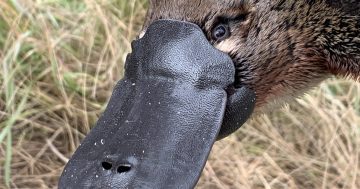As part of stumbling through the NLA’s Trove archive for flood stories, I came across the below article, a curious piece from the Sydney Morning Herald dated 25 October 1876 about the area immediately surrounding the junction of the Queanbeyan and Molonglo rivers.
Some credence (at least for the location, relative truthiness of any bunyip sighting is left open to the reader) is that today Hincksman Street in Queanbeyan leads onto the location in question.
A STRANGE ANIMAL – A remarkable amphibious animal – probably a veritable bunyip – is said by the Queanbeyan Age to have been seen in the Molonglo River, near the Queanbeyan Junction.
The river was in half-flood, and Frederick Hincksman, John McPherson, Luke Colverwell, and James Curley were about to cross. Hincksman entered first, followed by the others, McPherson bringing up the rear.
Where they entered the stream was about knee deep, and Hincksman’s horse shied at what he supposed was a rock, but as soon as he passed on the object proceeded up the river, following in the trail of the horsemen by a kind of diving undulating motion, frequently coming to the surface and again disappearing.
After landing on the other side the party pelted the animal with stones for a distance of fifty yards, when getting into the deep water it finally disappeared.
None of the party seem to be able to give a minute description of the creature, but McPherson, who had the best opportunity of viewing it, says its face resembled that of a child and that it swam with extended arms or long fins.
It was whitish in colour, and the size of a Newfoundland dog.
That some unknown animal has its abode in our rivers hereabouts, there can no longer be any doubt as several persons from time to time have caught a glimpse of it.
Do we still have an elusive population of Molonglo Bunyips, or have the years of Queanbeyan sewage spillover killed off what was already a threatened species?
(Also of note: This article from the Queanbeyan Age, 04 October 1918, with a bunyip allegedly in the Gininderra Creek, which at the time some suspected to have been a seal which swam upstream…)













